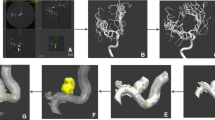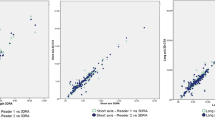Abstract
Geometrical aneurysm quantification is considered an important topic for the study of aneurysm formation, growth, risk of rupture and also in treatment planning. Usually, quantification involves aneurysm isolation, consisting in the operation of detecting the boundary between the aneurysm dome and its feeding arteries. This operation is sometimes performed manually, but it is a tedious task, subject to user variability. To obtain reproducible measurements, automatic techniques have been proposed. In this paper, we compare different aneurysm isolation techniques, two automatic and one manual-based on a cutting plane. All of them are compared against the results obtained by manual delineations of 26 real cases. We show from the results that automatic methods have good performance, providing results similar to manual methods in average. We also show that automatic methods improve reproducibility compared to direct measurements performed on volume rendering views. Each automatic method presents strengths and weaknesses in particular cases such as small aneurysms, aneurysms with multiple parent vessels or terminal aneurysms, but their reproducibility makes them suitable for robust population studies. Finally, based on this study, we have proposed a criterion that allows to use a combination of the two methods studied and that outperforms each of them individually.






Similar content being viewed by others
References
Bogunović H, Pozo JM, Villa-Uriol MC, Majoie CBLM, van den Berg R, van Andel HAFG, Macho JM, Blasco J, Roman LS, Frangi AF (2011) Automated segmentation of cerebral vasculature with aneurysms in 3DRA and TOF-MRA using geodesic active regions. An evaluation study. Med Phys 38:210–222
Bruijns J, Peters F, Berretty R, Barenbrug B (2007) Fully-automatic correction of the erroneous border areas of an aneurysm, Bildverarbeitung fr die Medizin, Springer, Berlin, pp 293–297
Cárdenes R, Pozo JM, Bogunović H, Larrabide I, Frangi AF (2011) Automatic aneurysm neck detection using surface voronoi diagrams. IEEE Trans Med Imaging 30:1863–1876
Dhar S, Tremmel M, Mocco J, Kim M, Yamamoto J, Siddiqui A, Hopkins L (2008) Morphology parameters for intracranial aneurysm rupture risk assessment. Neurosurg Clin N Am 63:185–197
Ford M, Hoi Y, Piccinelli M, Antiga L, Steinman D (2009) An objective approach to digital removal of saccular aneurysms: technique and applications. Brit J Radiol 82:S55–S61
Kang DG, Suh DC, Ra JB (2009) Three-dimensional blood vessel quantification via centerline deformation. IEEE Trans Med Imaging 28:405–414
ParaView v3.4.0 (2011) Kitware Inc, NY. http://www.paraview.org/
Larrabide I, Omedas P, Martelli Y, Planes X, Nieber M, Moya JA, Butakoff C, Sebastian R, Camara O, Craene MD, Bijnens BH, Frangi AF (2009) GIMIAS: an open source framework for eficient development of research tools and clinical prototypes. In: Proceedings of FIMH international conference, Nice, France, LNCS, vol. 5528/2009, 417–426
Larrabide I, Villa-Uriol M, Cárdenes R, Pozo JM, Macho J, Roman LS, Blasco J, Marzo A, Hose R, Frangi AF (2011) Three-dimensional morphological analysis of intracranial aneurysms: a fully automated method for aneurysm sac isolation and quantification. Med Phys 38:2439–2449
Ma B, Harbaugh, RE, Raghavan ML (2004) Three-dimensional geometrical characterization of cerebral aneurysms. Ann Biomed Eng 32:264–273
Millán RD, Dempere-Marco L, Pozo JM, Cebral JR, Frangi AF (2007) Morphological characterization of intracranial aneurysms using 3-D moment invariants. IEEE Trans Med Imaging 26:1270–1282
Mohamed A, Sgouritsa E, Morsi H, Shaltoni H, Mawad M, Kakadiaris I (2010) Computer-aided planning for endovascular treatment of intracranial aneurysms (CAPETA). In: SPIE: medical imaging 2010: visualization, image-guided procedures, and modeling, vol. 7625
Piccinelli M, Veneziani A, Steinman D, Remuzzi A, Antiga L (2009) A framework for geometric analysis of vascular structures: application to cerebral aneurysms. IEEE Trans Med Imaging 28:1141–1155
Raghavan ML, Ma B, Harbaugh RE (2005) Quantified aneurysm shape and aneurysm rupture. J Neurosurg 102:355–362
Sgouritsa E, Mohamed A, Morsi H, Shaltoni H, Mawad M, Kakadiaris I (2010) Neck localization and geometry quantification of intracranial aneurysms. In: IEEE international symposium on biomedical imaging, ISBI 2010, Rotterdam, NL, pp 1057–1060
Torii R, Oshima M, Kobayashi T, Takagi K, Tezduyar T (2009) Fluid–structure interaction modeling of blood flow and cerebral aneurysm: significance of artery and aneurysm shapes. Comput Method Appl M 198:3613–3621
Viñuela F, Duckwiler G, Mawad M (1997) Guglielmi detachable coil embolization of acute intracranial aneurysm: perioperative anatomical and clinical outcome in 403 patients. J Neurosurg 86:475–482
Wong W, Chung A (2006) Augmented vessels for quantitative analysis of vascular abnormalities and endovascular treatment planning. IEEE Trans Med Imaging 25:665–684
Acknowledgments
R.C. is funded by a Beatriu de Pinós Program, AGAUR, Generalitat de Catalunya, Spain. This Work is partially funded by CDTI CENIT-cvREMOD grant, CDTI, Spain, and FP7 VPH-NoE n.223920. A.F.F. is partially funded by an ICREA-Academia research award.
Author information
Authors and Affiliations
Corresponding author
Rights and permissions
About this article
Cite this article
Cárdenes, R., Larrabide, I., Román, L.S. et al. Performance assessment of isolation methods for geometrical cerebral aneurysm analysis. Med Biol Eng Comput 51, 343–352 (2013). https://doi.org/10.1007/s11517-012-1003-8
Received:
Accepted:
Published:
Issue Date:
DOI: https://doi.org/10.1007/s11517-012-1003-8




